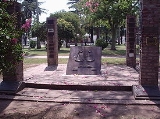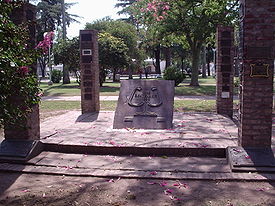
Carlos Pellegrini, Santa Fe
Encyclopedia
Carlos Pellegrini is a town
in the center-west of Santa Fe Province
, Argentina
.
 According to the 2001 census, it has 5,062 inhabitants: 2,555 women and 2,507 men. It has had a growth of 158 (5.41%) over the 1991 census.
According to the 2001 census, it has 5,062 inhabitants: 2,555 women and 2,507 men. It has had a growth of 158 (5.41%) over the 1991 census.
The area's economy is mainly farming and cattle
.
There are two elementary school
s, one middle school
and two rural schools.
The town has two radio station
s (FM
) and one TV Station.
at the intersection of routes 13 and 66, 170 km (106 mi) from the provincial capital
, 180 km (112 mi) from Rosario
, and 320 km (199 mi) from Córdoba
.
of the area is slightly undulated, with uniform characteristics and slight slopes, which help with communications. The soil is very apt for agriculture
. The area is located in an elevated terrain, at about 101 m (304 ft), which permits the natural draining of waters on all four points of the compass
. As a result, flooding is rare.
Climate
is temperate
. It has a humid period from March to July. The last two months are not humid because of precipitation
, but for the accumulated water in the soil
. August would be the only dry month if not for the aforementioned. No month of the year presents an excess of water. January and February have a deficiency of 60 mm (2.3 in) together. During the rest of the year there is no water deficit because evaporation
is amply covered with rain
and soil accumulation.
Town
A town is a human settlement larger than a village but smaller than a city. The size a settlement must be in order to be called a "town" varies considerably in different parts of the world, so that, for example, many American "small towns" seem to British people to be no more than villages, while...
in the center-west of Santa Fe Province
Santa Fe Province
The Invincible Province of Santa Fe, in Spanish Provincia Invencible de Santa Fe , is a province of Argentina, located in the center-east of the country. Neighboring provinces are from the north clockwise Chaco , Corrientes, Entre Ríos, Buenos Aires, Córdoba, and Santiago del Estero...
, Argentina
Argentina
Argentina , officially the Argentine Republic , is the second largest country in South America by land area, after Brazil. It is constituted as a federation of 23 provinces and an autonomous city, Buenos Aires...
.

The area's economy is mainly farming and cattle
Cattle
Cattle are the most common type of large domesticated ungulates. They are a prominent modern member of the subfamily Bovinae, are the most widespread species of the genus Bos, and are most commonly classified collectively as Bos primigenius...
.
There are two elementary school
Elementary school
An elementary school or primary school is an institution where children receive the first stage of compulsory education known as elementary or primary education. Elementary school is the preferred term in some countries, particularly those in North America, where the terms grade school and grammar...
s, one middle school
Middle school
Middle School and Junior High School are levels of schooling between elementary and high schools. Most school systems use one term or the other, not both. The terms are not interchangeable...
and two rural schools.
The town has two radio station
Radio station
Radio broadcasting is a one-way wireless transmission over radio waves intended to reach a wide audience. Stations can be linked in radio networks to broadcast a common radio format, either in broadcast syndication or simulcast or both...
s (FM
FM broadcasting
FM broadcasting is a broadcasting technology pioneered by Edwin Howard Armstrong which uses frequency modulation to provide high-fidelity sound over broadcast radio. The term "FM band" describes the "frequency band in which FM is used for broadcasting"...
) and one TV Station.
Location
It is located in the center-west of Santa Fe ProvinceSanta Fe Province
The Invincible Province of Santa Fe, in Spanish Provincia Invencible de Santa Fe , is a province of Argentina, located in the center-east of the country. Neighboring provinces are from the north clockwise Chaco , Corrientes, Entre Ríos, Buenos Aires, Córdoba, and Santiago del Estero...
at the intersection of routes 13 and 66, 170 km (106 mi) from the provincial capital
Santa Fe, Argentina
Santa Fe is the capital city of province of Santa Fe, Argentina. It sits in northeastern Argentina, near the junction of the Paraná and Salado rivers. It lies opposite the city of Paraná, to which it is linked by the Hernandarias Subfluvial Tunnel. The city is also connected by canal with the...
, 180 km (112 mi) from Rosario
Rosario
Rosario is the largest city in the province of Santa Fe, Argentina. It is located northwest of Buenos Aires, on the western shore of the Paraná River and has 1,159,004 residents as of the ....
, and 320 km (199 mi) from Córdoba
Córdoba, Argentina
Córdoba is a city located near the geographical center of Argentina, in the foothills of the Sierras Chicas on the Suquía River, about northwest of Buenos Aires. It is the capital of Córdoba Province. Córdoba is the second-largest city in Argentina after the federal capital Buenos Aires, with...
.
- Altitude: 101 m (304 ft)
- Latitude: 32º 03' S
- Longitude: 061º 48' O
Climate and topography
The topographyTopography
Topography is the study of Earth's surface shape and features or those ofplanets, moons, and asteroids...
of the area is slightly undulated, with uniform characteristics and slight slopes, which help with communications. The soil is very apt for agriculture
Agriculture
Agriculture is the cultivation of animals, plants, fungi and other life forms for food, fiber, and other products used to sustain life. Agriculture was the key implement in the rise of sedentary human civilization, whereby farming of domesticated species created food surpluses that nurtured the...
. The area is located in an elevated terrain, at about 101 m (304 ft), which permits the natural draining of waters on all four points of the compass
Compass
A compass is a navigational instrument that shows directions in a frame of reference that is stationary relative to the surface of the earth. The frame of reference defines the four cardinal directions – north, south, east, and west. Intermediate directions are also defined...
. As a result, flooding is rare.
Climate
Climate
Climate encompasses the statistics of temperature, humidity, atmospheric pressure, wind, rainfall, atmospheric particle count and other meteorological elemental measurements in a given region over long periods...
is temperate
Temperate
In geography, temperate or tepid latitudes of the globe lie between the tropics and the polar circles. The changes in these regions between summer and winter are generally relatively moderate, rather than extreme hot or cold...
. It has a humid period from March to July. The last two months are not humid because of precipitation
Precipitation (meteorology)
In meteorology, precipitation In meteorology, precipitation In meteorology, precipitation (also known as one of the classes of hydrometeors, which are atmospheric water phenomena is any product of the condensation of atmospheric water vapor that falls under gravity. The main forms of precipitation...
, but for the accumulated water in the soil
Soil
Soil is a natural body consisting of layers of mineral constituents of variable thicknesses, which differ from the parent materials in their morphological, physical, chemical, and mineralogical characteristics...
. August would be the only dry month if not for the aforementioned. No month of the year presents an excess of water. January and February have a deficiency of 60 mm (2.3 in) together. During the rest of the year there is no water deficit because evaporation
Evaporation
Evaporation is a type of vaporization of a liquid that occurs only on the surface of a liquid. The other type of vaporization is boiling, which, instead, occurs on the entire mass of the liquid....
is amply covered with rain
Rain
Rain is liquid precipitation, as opposed to non-liquid kinds of precipitation such as snow, hail and sleet. Rain requires the presence of a thick layer of the atmosphere to have temperatures above the melting point of water near and above the Earth's surface...
and soil accumulation.

